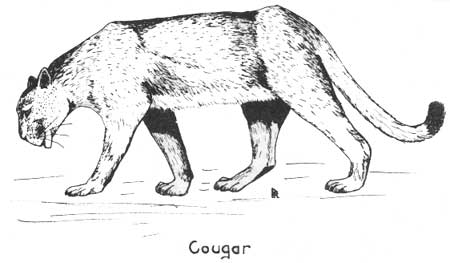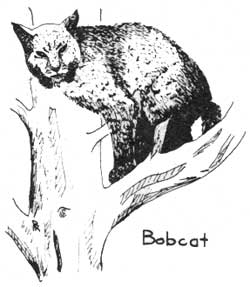|
ZION
Mammals of Zion-Bryce and Cedar Breaks |

|
Zion-Bryce Museum Bulletin
Number 2
MAMMALS OF ZION-BRYCE AND CEDAR BREAKS
List of Mammals
(continued)
GRAY FOX, Urocyon cinerecarenteus scottii. — This fox lives chiefly in the Upper Sonora Zone (4000 to 8000 feet), especially in chaparral. It has been seen in Zion Canyon and below Bryce rim; also tracks have been seen on both the East Rim and Horse Pasture Plateau in Zion, but it is apparently not common. It is gray in color, with buff-yellow sides and legs, paler below. It eats almost anything, preferring meat; often in the late summer it lives for days at a time chiefly on manzanita berries.
RED FOX, Vulpes fulva macroura. — The red fox is rare in this region. It has been reported a few times near Cedar Breaks, on the Markagunt Plateau, and once (1934) from Rainbow Mountain, at Bryce. The well known cross, silver and black foxes, are color phases of this species.
COYOTE, Canis latrans lestes. — This large coyote, locally often called "timber wolf", is not particularly abundant in any of the park areas. In Zion Park it is uncommon; in Zion Monument and Bryce it is occasionally seen or heard, and at Cedar Breaks it is present, although rare, in both winter and summer. It is not often encountered below 4000 feet at any time of the year. In the lowest semi-desert portions of Zion a smaller desert form has been reported; perhaps a wanderer from the more extensive Lower Sonoran Zone areas to the south. Contrary to popular belief, coyotes often feed on such small mammals as rabbits, squirrels and mice, in addition to larger game. They are among the most sagacious of wild animals, and have continued to live in settled districts long after many other species had been exterminated.
WOLF, Canis lupus youngi. — In early days wolves ranged over this entire region, but now probably are exterminated here. They have not been reliably recorded since 1918, when 3 or 4 were taken near Short Creek, about 15 miles south of Zion. Since that time "timber wolves" have been frequently reported, but they invariably prove to be large coyotes.

COUGAR, Felis concolor kaibabensis. — This large cat, which was once abundant from southern Canada to the Straits of Magellan, is now, within the United States, confined chiefly to the wilder portions of the western states. It is still fairly common throughout Utah and a few individuals are seen each year in the park areas. Due to its habit of hunting over a wide range, we cannot say just how many live within our areas — perhaps 10 in Zion Park and Monument combined, 2 or 3 in Bryce, and an occasional summer wanderer in Cedar Breaks. It is a stealthy animal, avoiding human beings, hence is seldom seen; and in human concentration areas like Zion Canyon even the tracks are rare. It never attacks human beings except under the most unusual circumstances, and need not be feared by anyone in the woods. Stories of its screams "like a woman in agony" are often told, but it is significant that few people have seen a cougar screaming. Usually they hear an unearthly sound, perhaps a young horned owl or a bobcat, and assume that it was a cougar. I have two or three times seen a cougar yowl, but not loudly.
Cougars are known by a variety of names — lion, puma, panther, painter, catamount, and many others. The first name is most commonly used in the west. The cougars of this region are large, measuring 6-1/2 to 8-1/2 feet in total length and weighing 125 to 220 pounds. Stories of cougars 9 or 10 feet long should be taken with a grain of salt — the skins always stretch.

BOBCAT, Lynx rufus uinta. — Three specimens of this large bobcat, or wildcat, were taken 2 miles east of Zion National Park, near Clear Creek Mountain, in 1933, 1936 and 1937; and it is probable that the animal is found sparingly in all portions of our region above 7000 feet. This is the largest of the bobcats, weighing 30 to 40 pounds, and local trappers often mistakenly refer to it as a Canada lynx, which can readily be distinguished by its skull. Also the Canada lynx usually has the entire tip of the tail black, whereas the bobcat has only a spot, or half-ring on the upper side of the tip. I have seen a Canada lynx from southern Utah.
BOBCAT, Lynx rufus baileyi. — This common wildcat is found in all of our areas except the high rim of Cedar Breaks. It does not seem to be at all averse to human beings, as is the cougar, and has been seen wandering at night among the tents in the Grotto Campground in Zion Canyon. Although tracks indicate that it is fairly common, it is seldom reported, since it hunts chiefly at night. When seen it is easily recognized as a cat — over twice the size of a house cat, long-legged and short-tailed, soft gray in color with indistinct rufous brown spots. It feeds chiefly on rodents and rabbits. It is sometimes rather noisy; I have several times heard bobcat "choruses" that were similar to the well known "song" of the domestic tomcat, although considerably louder. Also I have heard a bobcat purr.